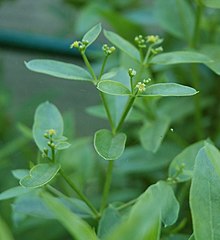Rubia tinctorum
| Rubia tinctorum | |
|---|---|
 |
|
| Scientific classification | |
| Kingdom: | Plantae |
| (unranked): | Angiosperms |
| (unranked): | Eudicots |
| (unranked): | Asterids |
| Order: | Gentianales |
| Family: | Rubiaceae |
| Tribe: | Rubieae |
| Genus: | Rubia |
| Species: | R. tinctorum |
| Binomial name | |
|
Rubia tinctorum L. |
|
Rubia tinctorum, the common madder or dyer's madder, is a herbaceous perennial plant species belonging to the bedstraw and coffee family Rubiaceae.
The common madder can grow up to 1.5 m in height. The evergreen leaves are approximately 5–10 cm long and 2–3 cm broad, produced in whorls of 4–7 starlike around the central stem. It climbs with tiny hooks at the leaves and stems. The flowers are small (3–5 mm across), with five pale yellow petals, in dense racemes, and appear from June to August, followed by small (4–6 mm diameter) red to black berries. The roots can be over a metre long, up to 12 mm thick and the source of red dyes known as rose madder and Turkey red. It prefers loamy soils (sand and clay soil) with a constant level of moisture. Madder is used as food plants for the larvae of some Lepidoptera species including the Hummingbird Hawk Moth.
It has been used since ancient times as a vegetable red dye for leather, wool, cotton and silk. For dye production, the roots are harvested in the first year. The outer brown layer gives the common variety of the dye, the lower yellow layer the refined variety. The dye is fixed to the cloth with help of a mordant, most commonly alum. Madder can be fermented for dyeing as well (Fleurs de garance). In France, the remains were used to produce a spirit as well.
The roots contain the acid ruberthyrin. By drying, fermenting or a treatment with acids, this is changed to sugar, alizarin and purpurin, which were first isolated by the French chemist Pierre Jean Robiquet in 1826. Purpurin is normally not coloured, but is red when dissolved in alkaline solutions. Mixed with clay and treated with alum and ammonia, it gives a brilliant red colourant (madder lake).
...
Wikipedia
